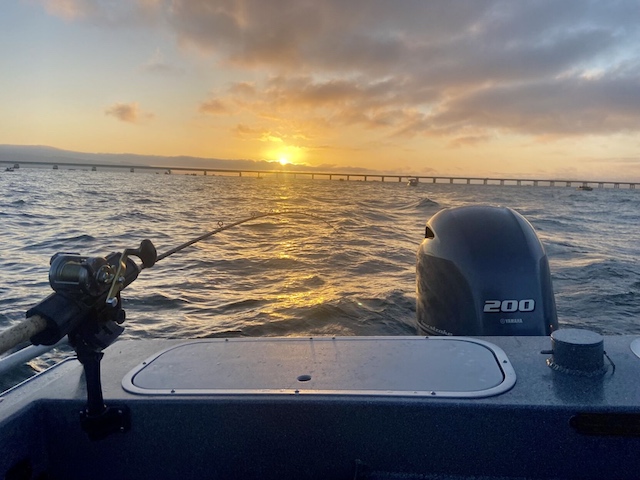forum
library
tutorial
contact

Landing a Chinook at Columbia River's
Buoy 10 Fishery may be a Challenge
by Roger Phillips
Yakima Herald-Republic, August 23, 2023
|
the film forum library tutorial contact |

|
Landing a Chinook at Columbia River's
by Roger Phillips
|
Boats were trolling above us and below us for as far as the eye could see.
Hundreds of boats? Yes. Thousands? Probably.
 We had only been on the water for a few minutes when my fishing rod started bucking.
We had only been on the water for a few minutes when my fishing rod started bucking.
I hollered "fish" and tried to run to the pole but the winds, currents and tides of the Columbia River pushed the boat up and down, left and right, making the short dash to the rod like walking in one of those fun house deals at the fair.
Being pretty much a klutz on flat land, the challenges Mother Nature was throwing at me made it a challenge for sure. It would have been funny but this late summer chinook fishing is serious business.
I was fishing with friends Doug Jewett and Chris Daniels near Astoria at the mouth of the Columbia River, in the fishery best known as Buoy 10. We were actually a mile or two from the famous buoy that marks the line between the Pacific Ocean and the mouth of the mighty Columbia, trying to catch one or two of the half million chinook salmon that are predicted to be running upriver in the next several weeks.
We weren't alone. As I grabbed the rod and felt the pull of a salmon that had hit my lure, I looked around. There were dozens and dozens of boats fishing near us.
Later, when the tides slowed, boats were trolling above us and below us for as far as the eye could see. Hundreds of boats? Yes. Thousands? Probably. All loaded with anglers hoping to catch a salmon.
This year the regulations at the Buoy 10 fishery are a little different than past years. Normally, at least for part of the season in this portion of the Columbia, anglers can keep any chinook salmon.
Not this year. Only hatchery salmon, identifiable by a clipped adipose fin, can be retained. And anglers can keep only one per day.
So, when the first fish of the day hit on Friday, I was hoping it might be a nice, bright, hatchery chinook salmon.
When I finally got the fish close enough to the boat to see it, we could see it was none of those things. It was small, and brownish, and it had a full adipose fin on its tail.
Counted in the estimated run of fall chinook is a run of tule chinook salmon. Pronounced "too-lee," the strain of salmon is distinctly different from the silvery bright upriver bright fall chinook.
Tules are a lower Columbia River species. They return to their point of origin in the late summer, typically between Aug. 1 and Sept. 1.
Some tule salmon are from wild stocks, which are considered to be threatened, which is part of the reason anglers are being asked to release all unclipped chinook. But a larger percentage are of hatchery origin.
The fish leave the Columbia and migrate north up the Pacific Ocean coast to Alaska waters. After four years, the tule salmon return to the Columbia to spawn.
Because they are closer to their spawning areas, the tules have already started their biological transition into a spawning mode. Their color has changed from a beautiful silver to a dull bronze hue.
And their meat has started to lose the bright red color. Basically, because of this transition, they are of poor eating quality.
These are not the prized salmon that the Buoy 10 fishery angler has come to catch. Even though there are plenty of hatchery origin tule salmon in the mix, most anglers will release them in hopes of catching an upriver bright fall chinook.
So, after hooking that first tule of the day, and then two more, we were wondering if we were ever going to catch a bright chinook. A short time later we did, but it was an unclipped fish, which was also released.
When the day was done, after being tossed about much of the day, avoiding boat after boat after boat, we had caught and released eight salmon. All but two were tules. Frustrating.
If you pay attention to the boats fishing in the lower Columbia you will see there are dozens of guide boats. Some are from Washington and some from Oregon.
Most have a minimum four clients aboard, while some have five or six. Each person has paid $250 for the day of fishing and I would guess most are hoping to take a nice salmon home as a reward for their day on the water.
For many of these guides, the Buoy 10 fishery is their real moneymaker. They rely on this fishery.
Based on what we saw this past weekend, it seems likely that only about a quarter of the fish caught were hatchery origin upriver bright chinooks. So, chances are there were more than a few disappointed anglers going home after their day on the water.
We ended up catching two keeper salmon the next day, a chinook and a coho. But, compared to years past, my cooler was pretty empty coming home.
With plenty of sockeye and spring chinook fillets in the freezer, though, I wasn't disappointed. I caught and released several hard-fighting salmon and we had a good time on the water.
If you are headed to fish at Buoy 10 in the days ahead, just be prepared. Catching a nice bright chinook to bring home for the grill will be more of a challenge.
learn more on topics covered in the film
see the video
read the script
learn the songs
discussion forum
